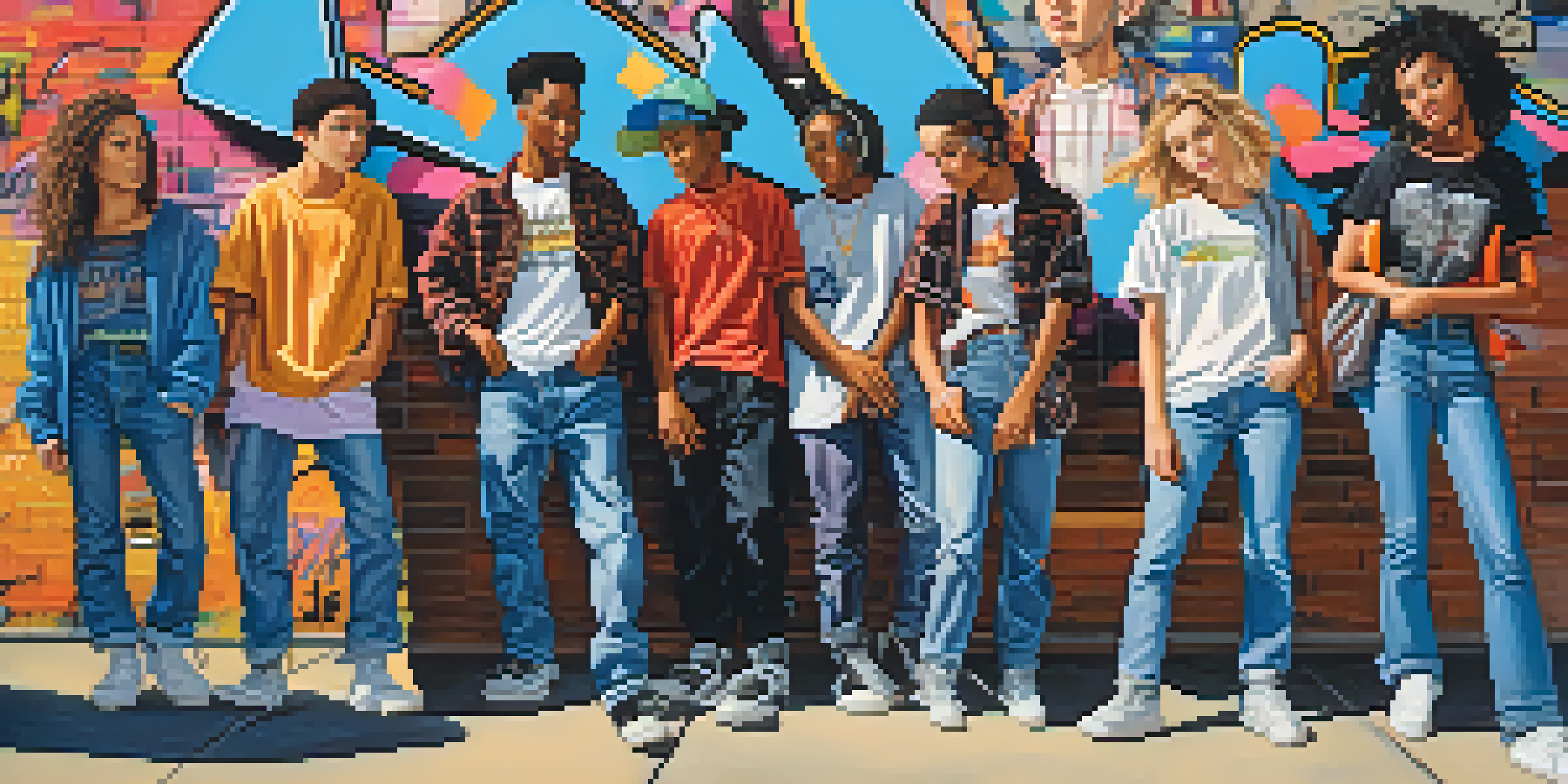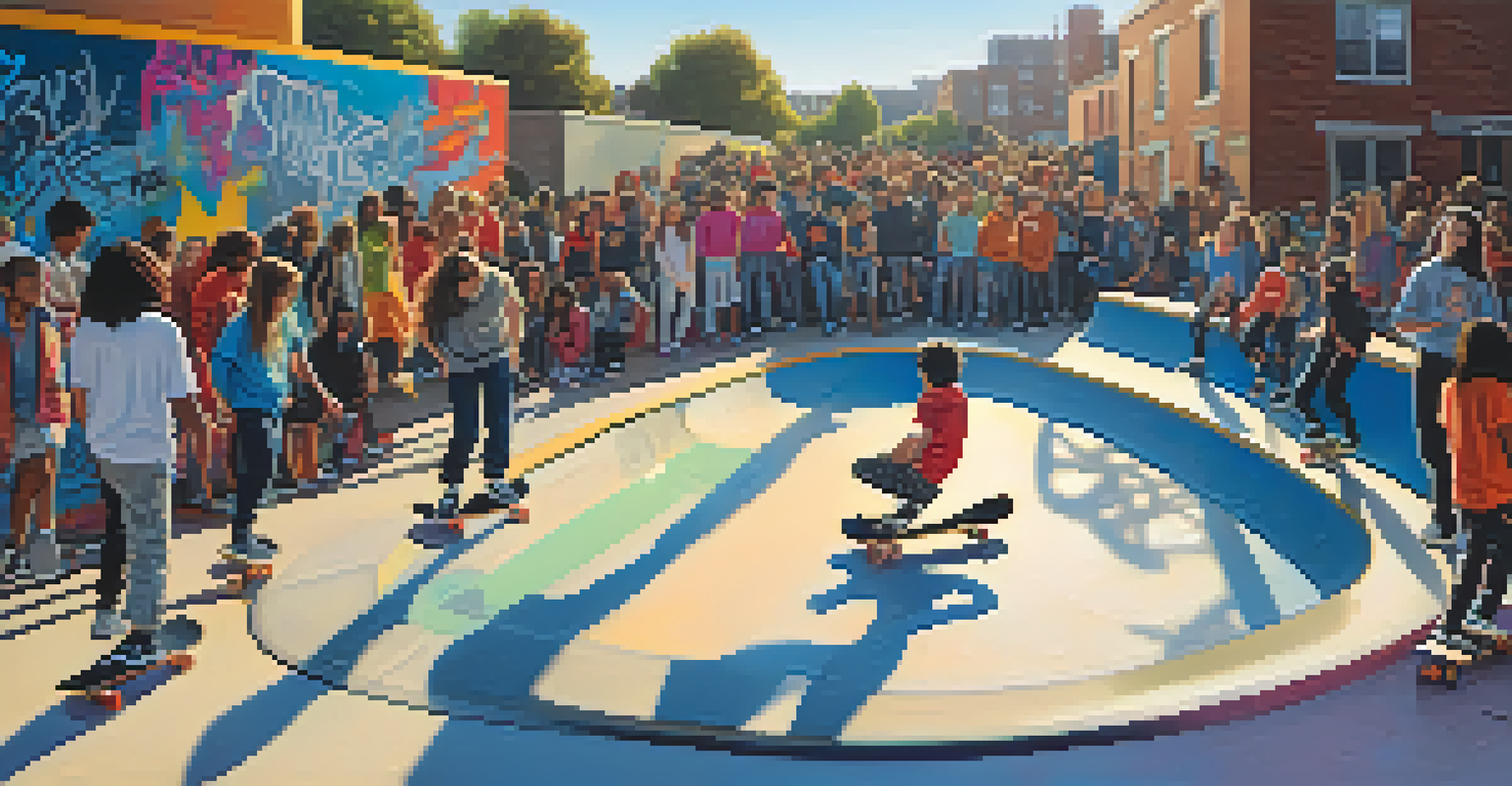The 1990s: The Rise of Streetwear and Grunge Culture

The Cultural Landscape of the 1990s
The 1990s were a unique time brimming with cultural shifts and changes. As technology advanced and globalization began to take hold, the world became more interconnected. This era saw the emergence of new music genres, including hip-hop and alternative rock, which would significantly influence fashion trends.
Fashion is the armor to survive the reality of everyday life.
In this vibrant environment, youth culture began to reject the polished aesthetics of the 1980s. Instead, they embraced a more casual, authentic look that reflected their attitudes and lifestyles. This shift laid the groundwork for the rise of streetwear and grunge fashion.
The streets became a canvas for self-expression, with fashion serving as a vehicle for social commentary. Whether through oversized tees or flannel shirts, the 90s youth used their clothing to showcase their individuality and resistance to mainstream norms.
Defining Streetwear: Origins and Influences
Streetwear, a blend of high fashion and urban culture, began gaining popularity in the early 1990s. It drew inspiration from skate and surf culture, as well as hip-hop music, which made its mark on the style choices of young people. Brands like Stüssy and A Bathing Ape emerged, creating a new fashion language that spoke directly to the youth.

One of the hallmarks of streetwear is its emphasis on comfort and practicality. Baggy jeans, graphic tees, and sneakers became staples, allowing wearers to move freely while making a style statement. This laid-back approach was a refreshing departure from the more structured fashion of previous decades.
Rise of Streetwear in the 90s
Streetwear emerged in the 1990s, blending high fashion with urban culture, emphasizing comfort and individuality.
Streetwear also embraced limited releases and collaborations, giving rise to a culture of exclusivity. This not only fueled demand but also fostered a sense of community among fans, who often shared their passion for the brands and styles on social media platforms.
Grunge Culture: A Rebellion Against Conformity
Grunge culture, often associated with the Seattle music scene, emerged as a powerful counterpoint to the mainstream. Bands like Nirvana and Pearl Jam captured the angst and disillusionment of a generation, influencing not just music but also fashion. Grunge style was characterized by its unkempt, thrift-store aesthetic, which celebrated imperfection.
Style is a way to say who you are without having to speak.
Flannel shirts, ripped jeans, and combat boots became symbols of this movement, representing a rejection of societal norms and expectations. The look was intentionally casual and often DIY, allowing individuals to express their rebellion through their clothing choices.
This raw, authentic style resonated with many, leading to a wider cultural acceptance of grunge fashion. It also influenced high fashion, with designers like Marc Jacobs incorporating grunge elements into their collections, blurring the lines between high and low culture.
Icons of the 90s: Celebrities and Influencers
The rise of streetwear and grunge was heavily influenced by celebrities and cultural icons of the 1990s. Musicians like Kurt Cobain and Aaliyah became style icons, showcasing how personal expression through fashion could resonate widely. Their unique styles inspired fans, creating a ripple effect that spread across the globe.
Television shows also played a significant role in popularizing these trends. Characters from shows like 'Friends' and 'The Fresh Prince of Bel-Air' showcased casual, trendy looks that blended both streetwear and grunge elements. This visibility helped to cement these styles in the cultural consciousness.
Grunge: A Rebellion in Fashion
Grunge culture, characterized by its thrift-store aesthetic, represented a powerful rebellion against societal norms and conformity.
As celebrities adopted streetwear and grunge aesthetics, they transformed them into must-have fashion statements. This crossover between music, television, and fashion solidified the cultural significance of these movements in the 90s.
The Role of Skate and Surf Culture
Skate and surf culture played a pivotal role in shaping the streetwear movement of the 1990s. These subcultures championed an active, carefree lifestyle that resonated with the youth. Skateboarding, in particular, became a symbol of rebellion and freedom, influencing not only music but also fashion choices.
Brands like Vans and Element catered to this audience, creating footwear and apparel that were both stylish and functional. The skate and surf aesthetic emphasized individuality, with each skater or surfer developing their unique style, further enriching the streetwear landscape.
This connection between sports and fashion allowed for a fluid exchange of ideas, leading to innovative designs that catered to both the street and the skate park. As a result, streetwear became synonymous with a laid-back, adventurous lifestyle.
The Evolution of Fashion in the 90s
As the 1990s progressed, streetwear and grunge began to evolve, reflecting societal changes and the influence of technology. The rise of the internet opened new avenues for communication and commerce, allowing brands to reach a wider audience. This digital expansion also fostered communities and fan bases that thrived online.
Fashion magazines and music videos showcased the latest trends, while online forums and social media platforms allowed fans to connect and share their styles. This democratization of fashion enabled individuals to express themselves in ways that were previously unattainable.
Cultural Influence of Celebrities
Celebrities and TV shows of the 90s played a crucial role in popularizing streetwear and grunge, making them mainstream fashion statements.
The blending of streetwear, grunge, and other influences like punk and hip-hop created a rich tapestry of styles. This fusion led to the emergence of new brands and designers who drew inspiration from these movements, ensuring their continued relevance in the fashion world.
Legacy of 90s Streetwear and Grunge Today
The impact of 1990s streetwear and grunge culture is still felt today, as many of the styles from this era have made a significant comeback. High-end fashion brands are now incorporating streetwear elements into their collections, blurring the lines between high fashion and everyday wear. This evolution highlights the enduring appeal of the styles born from the 90s.
Many contemporary brands and influencers draw inspiration from the aesthetics of this decade, celebrating the same values of individuality and authenticity. Vintage shops and thrift stores have become popular destinations for those seeking to channel that nostalgic vibe.

Ultimately, the legacy of the 1990s streetwear and grunge culture continues to inspire new generations, reminding us that fashion is not just about clothing—it's about identity and self-expression.